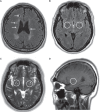Risk of "silent stroke" in patients older than 60 years: risk assessment and clinical perspectives
- PMID: 20852671
- PMCID: PMC2938031
- DOI: 10.2147/cia.s7382
Risk of "silent stroke" in patients older than 60 years: risk assessment and clinical perspectives
Abstract
With the increasing size of the elderly population and evolving imaging technology, silent brain infarction (SBI) has garnered attention from both the public and the physicians. Over 20% of the elderly exhibit SBI, and the prevalence of SBI increases steadily with age, ie, 30%-40% in those older than 70 years. Well-known cardiovascular risk factors such as hypertension has been identified as a risk factor of SBI (odds ratio [OR] = 3.47) Besides this, blood pressure (BP) reactivity to mental stress, morning BP surges, and orthostatic BP changes have been demonstrated to contribute to the presence of SBI. Further, a metabolic syndrome not only as a whole syndrome (OR =2.18) but also as individual components could have an influence on SBI. Increased C-reactive protein and interleukin-6, coronary artery disease, body mass index, and alcohol consumption have also been associated with SBI. The ORs and possible mechanisms have been discussed in this article. Overt stroke, dementia, depression, and aspiration pneumonia were all associated with SBI. (overt stroke: hazard ratio [HR] =1.9, 95% confidence interval [CI]: 1.2-2.8; dementia: HR =2.26, 95% CI: 1.09-4.70). We also looked into their close relationship with SBI in this review.
Keywords: elderly; risk factors; silent brain infarction; treatment.
Figures


References
-
- Vermeer SE, Longstreth WT, Jr, Koudstaal PJ. Silent brain infarcts: a systematic review. Lancet Neurol. 2007;6:611–619. - PubMed
-
- Kobayashi S, Okada K, Koide H, Bokura H, Yamaguchi S. Subcortical silent brain infarction as a risk factor for clinical stroke. Stroke. 1997;28:1932–1939. - PubMed
-
- Bokura H, Kobayashi S, Yamaguchi S. Distinguishing silent lacunar infarction from enlarged Virchow-Robin spaces: a magnetic resonance imaging and pathological study. J Neurol. 1998;245:116–122. - PubMed
-
- Wahlund LO, Barkhof F, Fazekas F, et al. A new rating scale for age-related white matter changes applicable to MRI and CT. Stroke. 2001;32:1318–1322. - PubMed
-
- Bernick C, Kuller L, Dulberg C, et al. Silent MRI infarcts and the risk of future stroke: the cardiovascular health study. Neurology. 2001;57:1222–1229. - PubMed
Publication types
MeSH terms
LinkOut - more resources
Full Text Sources
Other Literature Sources
Medical
Research Materials

